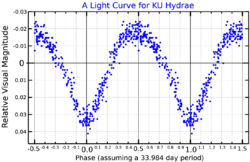KU Hydrae
Topic: Astronomy
 From HandWiki - Reading time: 3 min
From HandWiki - Reading time: 3 min
Short description: Star in the constellation Hydra
| Observation data Equinox J2000.0]] (ICRS) | |
|---|---|
| Constellation | Hydra[2] |
| Right ascension | 09h 22m 50.856s[3] |
| Declination | −09° 50′ 19.66″[3] |
| Apparent magnitude (V) | 6.75[4] |
| Characteristics | |
| Spectral type | Ap EuCrSr[5] |
| U−B color index | +0.11[6] |
| B−V color index | +0.22[6] |
| Variable type | α2 CVn |
| Astrometry | |
| Radial velocity (Rv) | 19.6 ± 5.0 km/s |
| Proper motion (μ) | RA: −27.94 ± 0.61[3] mas/yr Dec.: −13.01 ± 0.36[3] mas/yr |
| Parallax (π) | 6.92 ± 0.61[3] mas |
| Distance | 470 ± 40 ly (140 ± 10 pc) |
| Orbit[7] | |
| Companion | KU Hya B |
| Period (P) | 52.98(37) yr |
| Semi-major axis (a) | 0.169(1)″ |
| Eccentricity (e) | 0.074(8) |
| Inclination (i) | 68.5(6)° |
| Longitude of the node (Ω) | 202.4(4)° |
| Periastron epoch (T) | 2020.20(45) |
| Argument of periastron (ω) (secondary) | 58.7(3.3)° |
| Details[8] | |
| KU Hya A | |
| Mass | 2.07 M☉ |
| KU Hya B | |
| Mass | 2.05 M☉ |
| Other designations | |
| Database references | |
| SIMBAD | data |
KU Hydrae is a binary star in the constellation Hydra. The primary star is an Alpha2 Canum Venaticorum variable with its apparent magnitude varying from 0.05 magnitudes over a period of 33.97 days.[8]
This star was discovered to be a visual binary star by Robert Grant Aitken in 1906 and was given the double star designation A 1342.[9] Additional measurements of the position angle and angular separation showed a rapid orbital motion.[10]
References
- ↑ Adelman, Saul J. (January 2006). "FCAPT uvby Photometry of the mCP Stars HD 20629, HR 3724, 45 Leo, and HD 192678". Publications of the Astronomical Society of the Pacific 118 (839): 77–83. doi:10.1086/498223. Bibcode: 2006PASP..118...77A.
- ↑ Roman, Nancy G. (1987). "Identification of a Constellation From a Position". Publications of the Astronomical Society of the Pacific 99 (617): 695–699. doi:10.1086/132034. Bibcode: 1987PASP...99..695R. Vizier query form
- ↑ 3.0 3.1 3.2 3.3 3.4 van Leeuwen, F. (2007). "Validation of the new Hipparcos reduction". Astronomy and Astrophysics 474 (2): 653–664. doi:10.1051/0004-6361:20078357. Bibcode: 2007A&A...474..653V.Vizier catalog entry
- ↑ Ducati, J. R. (2002). "VizieR Online Data Catalog: Catalogue of Stellar Photometry in Johnson's 11-color system". CDS/ADC Collection of Electronic Catalogues 2237. Bibcode: 2002yCat.2237....0D.
- ↑ 5.0 5.1 "V* KU Hya". SIMBAD. Centre de données astronomiques de Strasbourg. http://simbad.u-strasbg.fr/simbad/sim-basic?Ident=V%2A+KU+Hya.
- ↑ 6.0 6.1 Johnson, H. L. (1966). "UBVRIJKL Photometry of the Bright Stars". Communications of the Lunar and Planetary Laboratory 4: 99. Bibcode: 1966CoLPL...4...99J.
- ↑ Tokovinin, Andrei et al. (2015-07-17). "Speckle Interferometry at SOAR in 2014". The Astronomical Journal 150 (2). doi:10.1088/0004-6256/150/2/50. Bibcode: 2015AJ....150...50T.
- ↑ 8.0 8.1 Rica Romero, F. M. (2010). "Orbital elements for eight binaries. Study of the nature of wide components. I". Revista Mexicana de Astronomía y Astrofísica 46: 263–277. Bibcode: 2010RMxAA..46..263R. http://www.astroscu.unam.mx/rmaa/RMxAA..46-2/PDF/RMxAA..46-2_frica.pdf.
- ↑ Aitken, Robert Grant (1907). "Two hundred and fifty new double stars: tenth list". Lick Observatory Bulletin 4 (109): 101–106. doi:10.5479/ADS/bib/1907LicOB.4.101A. Bibcode: 1907LicOB...4..101A.
- ↑ Aitken, Robert Grant (1929). "Measures of 296 A double stars". Lick Observatory Bulletin 14 (413): 62–87. doi:10.5479/ADS/bib/1929LicOB.14.62A. Bibcode: 1929LicOB..14...62A.
 |
Licensed under CC BY-SA 3.0 | Source: https://handwiki.org/wiki/Astronomy:KU_Hydrae
10 views | Status: cached on August 22 2024 20:40:33
↧ Download this article as ZWI file
10 views | Status: cached on August 22 2024 20:40:33
↧ Download this article as ZWI file
 KSF
KSF
